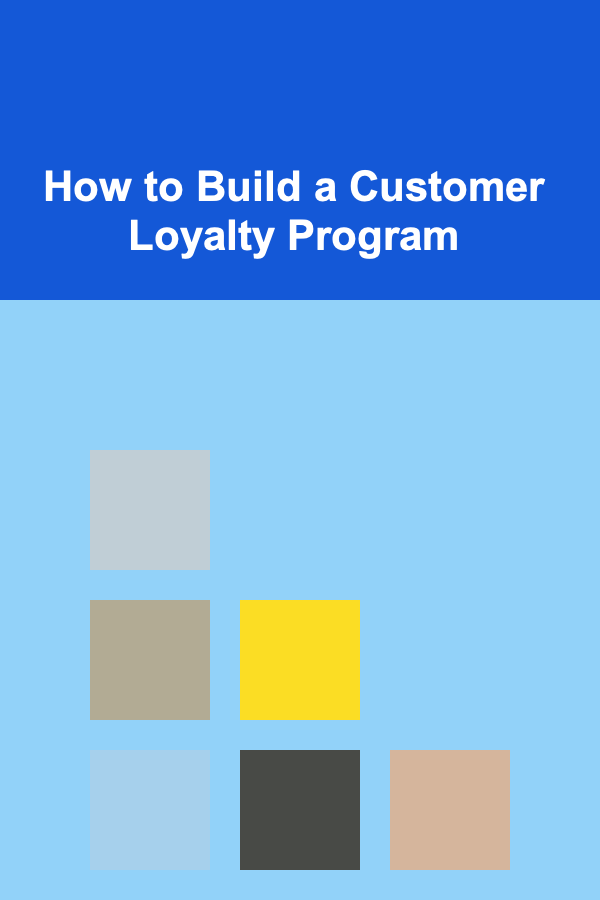
How to Build a Customer Loyalty Program
ebook include PDF & Audio bundle (Micro Guide)
$12.99$10.99
Limited Time Offer! Order within the next:

In today's competitive business environment, retaining customers is as important as acquiring them. A well-structured customer loyalty program can be a powerful tool to achieve long-term business success by fostering customer retention, increasing sales, and enhancing brand loyalty. Loyalty programs are not just about rewarding repeat customers; they serve as a strategic mechanism to create deeper connections with customers, increase customer lifetime value (CLV), and even drive new customer acquisition through word-of-mouth and referrals.
Building an effective customer loyalty program involves careful planning, understanding customer behavior, setting clear objectives, and continuously refining the program based on feedback and data. This article delves into the key elements of designing, implementing, and optimizing a customer loyalty program that not only rewards customers but also aligns with business goals.
Understanding the Importance of Customer Loyalty
Why Customer Loyalty Matters
Customer loyalty is a reflection of the trust, satisfaction, and positive experiences customers have with your brand. Loyal customers tend to make repeat purchases, recommend your products or services to others, and provide valuable feedback that helps improve your offerings.
Here are a few reasons why customer loyalty is crucial:
- Increased Revenue: Loyal customers are more likely to buy from you repeatedly, often spending more over time.
- Lower Acquisition Costs: Retaining existing customers is generally less expensive than acquiring new ones.
- Brand Advocacy: Satisfied, loyal customers can become brand advocates, helping to spread positive word-of-mouth and bring in new customers.
- Higher Lifetime Value: Loyal customers have a higher Customer Lifetime Value (CLV), meaning they will spend more over the course of their relationship with your brand.
Key Metrics to Measure Customer Loyalty
To design a successful loyalty program, it's important to measure customer loyalty effectively. Some key metrics to track include:
- Repeat Purchase Rate (RPR): Measures the percentage of customers who make repeat purchases over a specific time period.
- Net Promoter Score (NPS): Gauges customer satisfaction and the likelihood that customers will recommend your brand to others.
- Customer Retention Rate: Indicates the percentage of customers who continue to purchase over time.
- Customer Lifetime Value (CLV): Estimates the total amount a customer will spend on your products or services throughout their relationship with your business.
By monitoring these metrics, you can gain insights into customer behavior, identify trends, and adjust your loyalty program accordingly.
Defining the Objectives of Your Loyalty Program
Before jumping into designing a loyalty program, it's essential to define the objectives you want to achieve. Different businesses may have different goals for their loyalty programs, and clear objectives will guide the structure and execution.
Here are a few common objectives for a customer loyalty program:
- Increasing Repeat Purchases: Rewarding customers for their continued patronage encourages them to make more frequent purchases.
- Encouraging Higher Spend: Loyalty programs can incentivize customers to spend more per transaction in order to unlock rewards or higher-tier benefits.
- Enhancing Customer Engagement: A well-crafted program can increase the engagement of customers, encouraging them to interact more with the brand.
- Building Brand Advocacy: Loyal customers often become advocates who spread positive word-of-mouth and refer others to your business.
- Gathering Valuable Data: Loyalty programs can collect data on customer preferences, behaviors, and purchasing patterns, which can help you tailor marketing and product offerings.
The objectives you define will serve as the foundation of your loyalty program's design. For instance, if your goal is to increase repeat purchases, offering rewards after a specific number of purchases could be a good strategy. If your goal is to increase engagement, offering points or badges for different types of interactions (such as social media shares, product reviews, etc.) might be effective.
Choosing the Right Type of Loyalty Program
There are several types of loyalty programs, and each can be effective depending on your industry, customer base, and business objectives. Let's explore the most common types:
1. Points-Based Program
A points-based loyalty program is one of the most widely used models. Customers accumulate points for every purchase or specific actions (e.g., signing up, sharing on social media) and can redeem these points for rewards, discounts, or exclusive products/services.
- Advantages: Simple to understand, easy to implement, and flexible. Customers enjoy the ability to accumulate points over time.
- Examples: Starbucks Rewards, Sephora Beauty Insider.
2. Tiered Loyalty Program
In a tiered loyalty program, customers are grouped into different levels (or tiers) based on their spending or engagement. Higher tiers offer better rewards and exclusive benefits, motivating customers to climb the ranks.
- Advantages: Encourages higher spending and loyalty as customers seek to unlock higher levels of rewards.
- Examples: Amazon Prime, airline frequent flyer programs.
3. Cash-Back Program
A cash-back program offers customers a percentage of their spending back in the form of cash or store credits. This is a simple and straightforward loyalty model.
- Advantages: Easy to understand and appeals to customers who prefer tangible rewards.
- Examples: Discover it Cash Back credit card, some retail store loyalty programs.
4. Paid Membership Programs
A paid membership loyalty program requires customers to pay a fee upfront for access to exclusive benefits, such as free shipping, discounts, or VIP experiences.
- Advantages: Generates immediate revenue and ensures committed customers.
- Examples: Amazon Prime, Costco membership.
5. Game-ified Programs
Game-ified loyalty programs use elements of gamification, such as earning badges, completing challenges, or participating in competitions. This creates a fun and engaging experience for customers, motivating them to interact more with your brand.
- Advantages: Increases customer engagement and excitement around the brand.
- Examples: Nike Run Club, Starbucks Rewards (which incorporates elements of gamification).
6. Referral Programs
Referral programs reward customers for referring new customers to your business. This type of loyalty program relies on the power of word-of-mouth marketing.
- Advantages: Effective for customer acquisition, as people trust recommendations from their peers.
- Examples: Dropbox, Uber.
Creating a Seamless User Experience
The success of your loyalty program depends not only on the rewards you offer but also on the ease with which customers can engage with the program. A seamless user experience is crucial to encourage participation and avoid frustration.
1. Simple Enrollment Process
Make it easy for customers to join your loyalty program. Avoid complicated sign-up forms and ensure that the process is quick and user-friendly. Consider offering instant benefits or rewards upon enrollment to increase participation rates.
2. Clear Communication
Ensure that customers understand how the loyalty program works and what they stand to gain. Clearly communicate how customers can earn points, unlock rewards, and track their progress.
3. Mobile Accessibility
Since many customers use smartphones for shopping and browsing, ensure that your loyalty program is accessible through mobile apps or responsive websites. The ability to check points, redeem rewards, and receive notifications on the go enhances the customer experience.
4. Personalized Rewards
Use data from your loyalty program to personalize rewards and offers based on customer preferences, past purchases, or behaviors. Personalized experiences tend to resonate better with customers, increasing their engagement and loyalty.
Measuring and Optimizing Your Loyalty Program
Once your loyalty program is up and running, it's essential to track its performance and make continuous improvements. Regularly evaluate whether your program is meeting its objectives and adjust it as needed to keep customers engaged.
1. Monitor Key Metrics
Track essential metrics such as repeat purchase rates, customer retention rates, and CLV to gauge the program's success. Additionally, pay attention to the participation rate and the number of active members.
2. Solicit Feedback
Collect feedback from customers through surveys, focus groups, or direct interactions to understand what they like and dislike about the program. This will provide valuable insights into potential improvements.
3. Test New Ideas
Periodically test new features, rewards, or program structures to see what resonates best with your customers. For example, you could experiment with new ways to earn points or offer limited-time promotions to reignite interest in the program.
4. Refine the Rewards Structure
As you gather more data on customer preferences and behavior, refine the rewards structure to ensure that it remains attractive. For example, if customers prefer discounts over points, consider adjusting the balance between different types of rewards.
Best Practices for Building a Successful Loyalty Program
Building a successful loyalty program requires strategic thinking and a commitment to continuous improvement. Here are some best practices to follow:
- Focus on Value: Ensure that the rewards you offer are meaningful and provide real value to your customers. It's not about just giving away free items; it's about creating a sense of appreciation.
- Consistency: Be consistent in delivering rewards and benefits. Customers should know exactly what to expect when they engage with your program.
- Engage Customers Emotionally: Don't just reward customers for purchases---reward them for their relationship with your brand. Use loyalty programs to foster emotional connections by offering personalized experiences and acknowledging their milestones (e.g., anniversaries, birthdays).
- Integrate with Your Brand: Ensure that your loyalty program reflects your brand's identity and values. Whether you focus on sustainability, exclusivity, or fun, your program should align with your overall brand strategy.
Conclusion
A well-designed customer loyalty program can become one of your most valuable assets, driving repeat business, increasing customer lifetime value, and building a loyal customer base. By understanding the needs of your customers, defining clear objectives, choosing the right type of loyalty program, and delivering a seamless experience, you can build a program that not only rewards customers but also deepens your relationship with them. Continuous monitoring, data analysis, and customer feedback will ensure that your program stays relevant and effective in the long run, helping you stay ahead of the competition.

How to Make Money Online as an Occupational Therapist: 10 Actionable Ideas
Read More
How to Soundproof Your Home with DIY Materials
Read More
How to Track Your Expenses and Stay on Budget
Read More
Why You Need a System for Managing Holiday Gifts
Read More
Unleashing Citrus Aromas: A Deep Dive into Zesting for Baking Brilliance
Read More
How to Maintain Your Power Steering Fluid Flusher: A Comprehensive Guide
Read MoreOther Products

How to Make Money Online as an Occupational Therapist: 10 Actionable Ideas
Read More
How to Soundproof Your Home with DIY Materials
Read More
How to Track Your Expenses and Stay on Budget
Read More
Why You Need a System for Managing Holiday Gifts
Read More
Unleashing Citrus Aromas: A Deep Dive into Zesting for Baking Brilliance
Read More